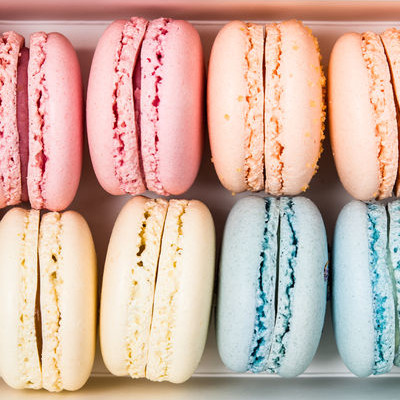
Artificial Colors
Also known as artificial colorants
What are Artificial Colors?
Artificial colors are food additives used to provide or enhance characteristic colors in food products. They are obtained from synthetic processes, and are typically made up of complex hydrocarbons, nitrogen and sulfur ions.¹
Compared to naturally extracted colors, artificial colors are more stable, economical, and available in a wider variety of colors. They are available in various forms:
- Liquid
- Liquid-gel
- Gel-paste
- Powder
- Oil-based
Origin
The origin of food colorants dates back to 1500 BC. The production of synthetic colorants is attributed to William Henry Perkin, who in 1856 accidentally discovered aniline purple. Shortly after, food colorants became more common. By the 1900s, around 695 food colorants became available.¹
Due to current the current natural and clean label trend, artificial colorants are becoming less appealing to consumers.¹
Function
In baking, artificial colors are used to provide color to frostings, cake batters, breads, cookies, muffins and fillings.¹ Artificial colors are used in baked goods to:¹
- Provide colors
- Enhance existing colors
Commercial production
Artificial colors are manufactured through the following process:3
- Synthesis: chemical compounds are mixed to produce the target color
- Filtration and washing using appropriate solvent to form a dispersion or paste
- Drying: color compounds are dried and later ground to the appropriate particle size
Application
Two main categories of artificial colors are used in food production:
- Dyes: are water soluble, and are sold as liquid or powders. They are commonly used in beverages, dry mixes, baked goods, dairy products and fillings.
- Lakes: are water insoluble. They are commonly used in products with a lower liquid content such as: coated tablets, cake mix, donut mix, cheese and margarine.
Artificial colors are used in the manufacture of several baked goods such as cakes, cookies, muffins and cupcakes. Also, they are common in the production of frostings, fillings and jellies.1,2
Some considerations when using artificial colorants:¹,²
- Potential interactions with cereal of flour matrices
- Baking temperature
- pH
- Solubility of the colorant in water or oil
A concentration of 1.5 – 3% of water-soluble colorant provides a good dough dispersion. Lakes are preferred due to their oil-soluble nature.1,2
Regulations
Currently, seven FDA-certified food colorants are permitted for use in food products. Two other artificial colors (Orange B and Citrus Red #2) are approved for external use in particular food products.4
In the EU, color additives are regulated by the EC NO1333/2008.5
FDA approved artificial colors:1,2,4,5
| Color Additive | Commercial Name | Color produced | Use | Acceptable Daily Intake | Permitted in the EU |
| Blue #1 | Brilliant Blue FCF | Blue | Sensible to heat, light and acid conditions. Color may fade with ascorbic acid.
|
0 – 10 mg/kg | Yes |
| Blue #2 | Indigotine | Indigo | 0 – 5 mg/kg | Yes | |
| Citrus Red #2 | Citrus Red | Orange | Only approved for use on orange skins or peels not intended processing. | 2 ppm of whole fruit | No |
| Green #3 | Fast Green FCF | Turquoise | Used in confections and frostings. | 0 – 25 mg/kg | No |
| Red #40 | Allura Red AC | Red | Stable in acid, high heat and light exposure conditions. Stable with ascorbic acid.Typically used in soft drinks. | 0 – 7 mg/kg | Yes |
| Red #3 | Erythrosine | Pink | Insoluble in acidic pH. Used in cocktails, and cherries. | 0 – 0.1 mg/kg | Yes |
| Yellow #5 | Tartrazine | Yellow | Stable in acid, high heat and light exposure conditions. It can fade with ascorbic acid. | 0 – 7.5 mg/kg | Yes |
| Yellow #6 | Sunset Yellow FCF | Orange | 0 – 2.5 mg/kg | Yes |
References
- Grumezescu, A. M, and Holban, A.L . Natural and Artificial Flavoring Agents and Food Dyes. Vol. 7. Academic Press, 2017, pp. 83-110.
- Socaciu, C. Food colorants: chemical and functional properties. CRC Press, 2007.
- Rosa, J.M, Basile, E, Curvelo, C. De Campos, Carlos, Ming, W and Trindade, N . “Development of colors with sustainability: a comparative study between dyeing of cotton with reactive and vat dyestuffs.” Textile Research Journal 84.10 (2014): 1009-1017.
- Food and Drug Administration (FDA). US Department of Health and Human Services. CFR Code of Federal Regulations Title 21, Part 70 Color Additives, https://www.accessdata.fda.gov/scripts/cdrh/cfdocs/cfcfr/CFRSearch.cfm?CFRPart=70&showFR=1&subpartNode=21:1.0.1.1.25.1 . Accessed 13 September 2020.
- European Commission (EC). Commission Regulation NO1333/2008 of the European Parliament and of the Council of 16 December 2008 on food additives. Official Journal of European Communities, 16 December 2008.

